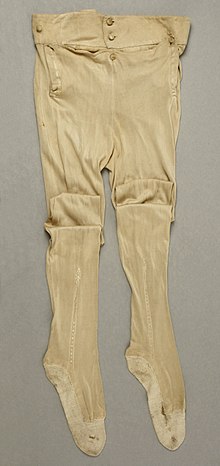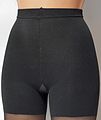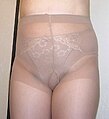Pantyhose
The pantyhose is an abdominal clothing usually made of two stockings , which completely covers the body from the waist down.
Depending on the processing and personal preference, their use ranges from a seamless combination of underpants and stockings to tight-fitting upper trousers that also cover the feet. One of the main functions is to offer an alternative to suspenders or hold-ups. The continuous coverage also offers better emphasis or cosmetic improvement of the appearance of the legs and protection from the cold.
Manufacturing
Today, tights are usually knitted in the factory on knitting machines . This is why they are prone to ladder .
history

If you define pantyhose as a pair of long stockings attached to shorts and note that up to the 16th century, stockings were not knitted or knitted, but made of woven fabric, then the history of pantyhose in European clothing goes back to back to the 15th century. However, the differentiation to pants or underpants is difficult or impossible.
15th to 18th century
Early forerunners of pantyhose go back to the medieval leg warmers , i. H. on men's stockings that were attached to the belt. In the 15th century, the leg warmers were combined into a piece of clothing with a gusset sewn in between . Such trousers have been preserved in Alpirsbach and are dated around 1500. In the 16th century, the stockings were separated from the trousers ( army drum ), but attached to them . Knitted stockings also appeared as the century progressed . When trousers became knee-length at the beginning of the 17th century, annestling also became unnecessary. Only at the end of the 18th century did pantyhose return - still as a men's clothing item - under the name of pantaloons , albeit as underwear, so that only the presence of foot parts distinguishes them from long johns. In the course of the partially transparent, body-hugging revolutionary fashion, they were also worn by women for the first time.

First half of the 20th century

The pantaloons of the late 18th century became footless long johns in the 19th century, so it can be said that tights were not worn in the 19th century. In the 1920s to 1940s, dancers and actresses sometimes sewed their stockings onto their underpants, but there was no industrial production. After one of the largest advertising campaigns in consumer history, Du Pont launched nylon stockings on May 15, 1940, “Nylon Day” . In 1959, the Glen Raven company launched the first panty pants made of synthetic fibers. In 1956 Ernest Rice had already filed a corresponding patent, which was approved in 1958, which led to legal disputes.
1960s
Nylon tights (fine tights)
The tights quickly caught on in the following years and were advertised as a mass product. As early as 1966, the share of tights in the total nylon stocking production was 77%, two years later the share had risen to 85%. At the time of the miniskirt , nylon tights largely replaced the nylon stockings with suspender belts and girdles that had been customary until then , but initially still had an opaque panty section. The need to do without this arose only with the advent of the " hot pants " (1971).
In addition to nylon, the chemically related perlon was also used. Nylon tights quickly became a mass product in the western states, but in the Eastern Bloc they were still a scarce commodity for a long time, as was the case in the GDR . Here a material similar to nylon was used, the Dederon .
Knitted tights
Around the same time, more and more knitted tights came onto the market. They were worn under long pants to protect against the cold, less often with skirts and dresses, as nylon tights were considered finer here.
Children's tights
In addition, knitted tights became a very popular item of clothing for children from the 1960s onwards. Since then girls have been wearing them under skirts and dresses, boys in the colder months under long trousers. In the 1960s, some boys wore knitted tights in combination with shorts. The tights replaced long woolen stockings, especially in cool weather. In the GDR it was common for boys, more rarely girls, to wear tights inside rooms without another item of clothing covering them; this fashion almost completely disappeared in the early 1990s. In the early 21st century, children's tights are still commercially available for both sexes, mostly made of cotton , polyester and elastane , and for many parents they are a staple in children's clothing.
Men's tights
In the 1960s and 1970s, (knitted) tights for men were increasingly produced. In order to increase demand, non-invasive pantyhose that can be worn by both sexes came on the market with engagement-specific models. Compared to the non-invasive models, these met with only limited interest.
1970s and 1980s
When the wave of enthusiasm for hot pants subsided at the beginning of the 1970s, as well as the replacement of mini fashion by midi and maxi dresses and the increasing acceptance of long trousers in women's fashion, tights largely lost their “fashionably chic” status and became common goods. Warm knitted tights were often worn under long trousers in winter. Tights with terry soles or terry inserts in the knees and buttocks were also on the market in the 1970s; these years are considered the heyday of knitted tights.
In the 1970s, with the increasing prevalence of body awareness, nylon tights with higher yarn strengths came into fashion, which offered supportive or figure-shaping effects.
At the end of the 80s , pop culture , with artists like Madonna or Prince , made opaque (and mostly colorful) tights without feet - called leggings - popular.
1990s
At the beginning of the 1990s, the fashionable trend of combining tights with short to half-length trousers for women was briefly repeated.
In the mid-1990s, women began to use knitted tights with (often colorful) stripes. The knitted tights have freed themselves a little from their previous image as children's tights or warming underwear and are increasingly being used as a fashion accessory .
21st century
Instead of tights, thermal underwear (functional underwear) is now offered and worn as warming underwear. Women and girls continue to wear tights as a fashion accessory for skirts, dresses and hot pants , and knitted-in patterns are enjoying increasing popularity thanks to the technical improvement in knitting machines . In the men's segment, in addition to the long-established knitted tights, in the last few years there have also been occasional fine tights for men with and without intervention, which are enjoying growing sales; their pattern is more adapted to the anatomy of the male body. The strengths vary from 15 to 100 den. At the end of the first decade, long sweaters for women, for autumn and winter in fashion, which are worn with fine tights over 60 denier or terry thermal tights. Both variants are also offered as leggings with unclosed toes. This modification of fine tights is also worn casually with long shirts, shorts and mini skirts in summer.
2010s
The footless versions are being replaced by thicker leggings, the leg parts of which are neither round knitted nor translucent. In 2017, fishnet tights will come into fashion again, which mostly shine through the holes of torn jeans or flirtatiously adorn the stomach from the waistband of the jeans sitting on the hips to the waist.
This decade, Kate Middleton became the fashion model for skin-colored nylon tights, which were previously mandatory for women in many business sectors . Overall, however, the trend was towards bare legs, while stockings in skin tones were considered old-fashioned.
Structure of the tights
The simplest and therefore cheapest variant consists in separating two stocking tubes above the legs and sewing them together along the two cutting edges. In addition, there are other individual parts or patterns for production.
individual parts
Stocking and panty part
A large number of materials and patterns can be woven into both stocking tubes , which form the leg and panty section.
- Marking of the panty part by optically contrasting with more durable reinforcement of the panty part in fine tights or smooth knitted areas of patterned knitted tights as boxers, shaped pants , bikini or thong panties.
- In the look of stockings, as well as all the decorations that can be found on real stockings.
- Reinforcement of the tips of the toes against ladder stitches. Reinforcement of the central seam and grip edge as a T-band. Foot parts with open toes or completely footless to form leggings or even shorts
- Weaving in cotton to absorb sweat better or to keep you warm
A side effect of weaving in additional or thicker materials is the reduction in elasticity. What can prevent the panty part from slipping and shape certain areas such as the stomach and bottom. But it can also lead to unsightly cuts at transitions and ends. This can be remedied by fanning out fine patterns at the transitions or asymmetrical knitting techniques that make large comfort gussets and the unattractive seams above the buttocks superfluous.
gore
→ Main article: gusset
The gusset is an optional insert to compensate for stretch and improve the fit between the leg parts. Similar to synthetic briefs , this part of the crotch area of fishnet and nylon tights is often coated with cotton for better moisture absorption . Although this feature is supposed to provide additional comfort on the skin, it is a rarity for comfort gussets.
Federation
This can already be woven into the stocking tubes in various designs or only sewn on afterwards. The last-mentioned sewn-on waistband is standard for seamless tights for technical reasons. This can also consist of lace several centimeters wide. Other waistband solutions consist in merely reinforcing a wide part with additional elastane and cutting the upper end of the stocking tubes with a laser during production and at the same time welding them to prevent them from being opened.
Additional equipment
Some tights offer additional features such as many-to-find procedures for men tights. The female counterpart in the form of two overlapping cotton gussets that are only sewn on one side is rarer. This can be found in figure-shaping models that reach below the chest to cover the entire stomach and not cut into the waist. Here, the waistband can also be prevented from sliding down with a silicone coating, as with hold-up stockings or with shoulder straps.
Special forms
Seamless
This shape can often be found in fishnet tights and sheer tights from premium brands . These tights only have seams on the sewn-on waistband, the tips of the toes and around the optional hygiene gusset . In fine tights, the gusset can even be seamlessly woven in. Seamless processing is not possible with yarn thicknesses over 80 denier, such as knitted tights.
Briefs with stockings
A shape that is still seldom found today and resembles the first attempts at fine tights. Here stockings were simply sewn to ordinary panties. For series production , there are no endings at the leg cut-outs unless the panty is intended to be reused after the stockings are worn out. To prevent overstretching between the leg cut and the edge of the stocking, the stockings are made longer than standard thigh stockings. The advantages of this variant are the individual size of the panty section and the disappearance of the central seam on the stomach and back.
material
Yarn count
The fineness of the used in the manufacture of tights yarn is in the units denier (den) and decitex (dtex) specified, the traditional indication of the still widely used in Germany. Although both numbers are used as a measure of the transparency of the leg part, they actually indicate the weight of a yarn in relation to the length and are always given in whole numbers. In fact, the transparency is determined by the mesh size, which can change depending on the stretch on the body. Support tights with 140 denier are also available in transparent versions. The denier values of conventional fine tights are roughly between transparent 15 denier and warmer opaque 80 denier. Extremes like 3 den or 150 den are seldom encountered. Unless specified separately, the specified strength refers to the leg section. Reinforcements can be worked twice, but other areas can also be made finer.
Types of tights
Sheer tights
Fine tights are mostly made of microfibres such as nylon (polyamide), polypropylene, elastane (also known under the brand names Lycra or Spandex), Meryl, but silk is also used. Made possible by new technologies, tights treated with natural essences such as ginkgo , aloe vera and ginseng were also produced, which were supposed to care for the skin and prevent tired legs. However, the benefit here is questionable, as the effect is lost after several washes.
Fine tights are available in different thread thicknesses, so that they can be made almost transparent as well as opaque . They are made from very thin threads and are accordingly sensitive (see: Ladder ). Fine tights are produced in practically every imaginable color, but the most popular are transparent or skin-colored and black.
Strictly speaking, the division into fine tights and knitted tights is not entirely correct, since fine tights are also knitted (and not woven). Fine tights are made up of around two million stitches, and around five to six kilometers of yarn are needed to make them.
In advertising photography, black nylon tights in particular are used as fetish clothing because, like other tight-fitting items of clothing such as evening gloves or corsets, they represent a “second skin” and emphasize certain body parts or reveal their shape. In order to achieve the desired effect, the gloss effect is technically enhanced or the image composition is adjusted accordingly. This presentation as a fetish object is regularly used as an advertising medium for many items that have nothing to do with clothing.
Shaping tights
Practically one of the archetypes of modern fine tights. In this case, in accordance with the patent by Ernest G. Rice, it usually has transparent legs and opaque panties in the shape of a page. The predetermined breaking point , which makes it possible to keep the panties if the leg parts are destroyed, has practically disappeared. However, in today's models, the gusset mentioned only in passing is almost always made of cotton. For the purpose of shaping the figure more strongly, additional elastane is processed in the panty section. Since the mid-1980s, it has been possible to manufacture more complicated structured panty parts. So it is possible to specifically shape or even highlight certain areas, e.g. B. the buttocks. This is why this type of pantyhose is also offered with short leg parts as molded pants, a kind of long girdle pants . Despite the lack of a predetermined breaking point, it is also possible to obtain these shaped trousers by carefully separating the (damaged) leg parts from figure-shaping tights.
Support and compression tights
Patients with venous disorders and lymphedema are often forced to wear special compression stockings or pants. These are particularly firm and exert a defined pressure on the legs. This pressure is higher with compression tights (approx. 3 kPa ) than with support tights (approx. 1 kPa ). Support stockings are used to prevent thrombosis. They are not recommended if you have an illness.
Glossy tights
Under Glanzstrumpfhose one understands a usually very shiny pantyhose as it is for example worn in dance sport. Since these tights are often used in these sports, they are very resistant to running stitches and other damage. Most models are available in dark skin tones with a yarn count of 70 to 90 denier and crotch gussets made of cotton or Coolmax .
Knitted tights
Knitted tights are made from thicker, spun yarns than fine tights, mostly made of cotton or wool with an admixture of synthetic fibers such as elastane , which makes the tights stretchable. They are made with special knitting machines. Knitted tights are thicker and warmer than fine tights. They are available both plain knitted and with a structured surface (ribbed in different widths or with a cable pattern).
Patterned structure on a fashion show
Fishnet tights
Fishnet tights, or ajour stockings, have a net-like, holey structure. They are mostly seamless and have only one toe reinforcement. As with fishnet stockings , they are associated with eroticism, especially with wide stitches or back seams on the leg. They are also tolerated in tight-knit versions as an airy alternative to fine stockings in strict dress codes .
With a back seam on the leg for tango
Special tights
In addition, tights are produced that meet special needs. Examples are:
- For pregnant women with an adjustable waistband or waistband that ends above the stomach, which can also support the stomach.
- Hip tights with a lower panty section, which can be worn under hip pants and skirts without the waistband of the pantyhose being visible
- Men's tights
- Ski tights with terry cloth on the inside
- Summer tights in very thin DEN thicknesses and often without toe reinforcement for open shoes
- Open crotch crotchless tights
- "Over Boot" -Strumpfhose with open soles , which over the shoes or boots (English: boat ) be slipped in the ice or also optionally be worn as leggings can
Man with tights in tattoo patterning
Modifications of tights
During production or later by hand, other items of clothing can also be produced, which thus retain certain basic properties of the tights. Such as B. seamless leg parts or simply cheaper manufacturing costs.
- Hip stocking as a support or compression stocking in the medical sector or as a (recycled) alternative to thigh stockings.
- Form panties
- Pantyhose the length of a cycling short to reduce the mutual chafing of the skin of the thighs
- Leggings without a foot piece or with a foot bridge
- Jeggings like leggings, but made of denser material in a denim look
- Bodystockings as tight-fitting full-body jerseys
- Special tights with an erotic appearance, for example crotchless and suspender tights that are also open at the sides or mesh bodystockings
Singer with a bodystocking under her leotard
Wearing habits
In addition to personal comfort and the type of pantyhose, wearing habits are also determined by the pragmatic purpose and current fashion . It is not uncommon to wear other underwear such as briefs under or over bodysuits , girdles, or jazz pants .
Purposes
The purposes include:
- An attractive show.
- Hiding physical imperfections such as blemishes, complexion, bruises, scars, cellulite , hairs and varicose veins.
- Avoidance of visible slip lines .
- Reduce the chafing between feet and shoes or the thighs.
- Extra warmth.
- Nylon tights in skin or gray tones or in black as a dress code in conservative industries and authorities.
- Different types and uses from the beginning of the 20th century to the present day
Transparent as fishnet tights tucked under a dance dress, which on a leotard is based
Or nylon for the high leg cut under leotard and pumps
If there is insufficient hygienic equipment or shame , underpants are also worn underneath.
Comfort
In addition to the fit, the lack of breathability and moisture retention of nylon represent a reduction in wearing comfort. As with swimwear and sportswear, normal use as underwear can be uncomfortable or even impossible. This means that stockings , underpants and leggings that are available separately are also used or combined with tights.
Intimate area
For the best air circulation and cooling, it is recommended to wear tights with cotton gussets without additional underwear. If this gusset is missing, just wear cotton underwear underneath to keep out more moisture. However, the lack of breathability remains and the heat increases. Thigh stockings are also perceived as an alternative to tights.
Feet
If the foot section is present, tights should not be worn for several days like outerwear, but should be changed daily like socks. In rare cases, inserts made of cotton or fibers mixed with silver can be found in the sole area. There are also foot parts with open toes , originally intended for diabetics or crooked toes.
Use
- In addition to keeping the legs warm in cold weather, it can also reduce the drying out of the skin in low humidity.
- Since the material has pores and is in direct contact with the skin, some manufacturers bring in skin care products. Moisturizing and other skin creams are introduced by means of microencapsulation , which dissolve at body temperature. Some manufacturers even went so far as to use caffeine for cellulite . However, its effect is doubtful.
- Fine tights also serve as protection against insect or jellyfish stings as well as sand, as more meshes are packed tightly together in less space. These are also made more densely woven especially for men in appropriate proportions with engagement.
criticism
- For very stocky people, tights can be extremely uncomfortable. Tights for wide legs are rarely offered and even then have a waist-high waistband that is only held on the hips and thus allows the remaining material to slide down.
- Some people reject tights for financial and resource reasons. First of all because of the ease with which tights run or tear. On the other hand, because they are usually not biodegradable or not recycled. Although ladder-free tights exist, these are only marginal.
- The idea of pantyhose as underpants can be reluctant to use for a variety of reasons. This includes personal hygiene requirements, especially in the low-price sector, that are insufficiently met or that the panty is considered too transparent and sensitive. But also cultural reservations that consider not wearing simple underpants as inappropriate or unhygienic.
- Panty liners can be glued directly into pantyhose, but because the panty section is stretched a long way, the panty liner must also be able to keep up. Otherwise it will peel off or be compressed. Accordingly, thicker sanitary napkins without glue must be held by their own size, as in fixation pants of the same design. Otherwise, figure-shaping tights as well as existing bodysuits / leotards or corsetry ensure a tight fit.
Different purposes
In earlier years, a broken V-belt could be replaced by a woman's stocking or sheer tights, as has been proven for the VW Beetle or the Trabant, for example. However, this is no longer possible with modern vehicles.
literature
- Ingrid Loschek : Fashion in the 20th century, a cultural history of our time. Bruckmann, Munich 1988, ISBN 3-7654-2161-8 .
- Foundation House of the History of the Federal Republic of Germany (Ed.): Artificial temptation. Nylon - Perlon - Dederon. (Book accompanying the exhibition in the House of History of the Federal Republic of Germany, Bonn, April 23 to August 22, 1999.) Wienand, Cologne 1999, ISBN 3-87909-640-6 .
- Susanne Buck: Wrought miracles, delicate dreams - about women's legs and pearl stockings. Jonas-Verlag, Marburg 1996, ISBN 3-89445-199-8 .
Web links
Individual evidence
- ↑ a b Glen Raven, Inc .: Reciprocal advertisement How do gals get this sleek bell bottom look without the bumps of garters and panties? - They don't wear any. They wear Glen Raven Panti-Legs in Cantrece. USA, 1966
- ↑ a b (English) Patent US 2826760 , Ernest G. Rice: Combination Stockings and Panty , published March 18, 1958
- ↑ a b c d e f Patent US 20030196252 , Sara Blakely: “Two-ply body-smoothing undergarment”, published on October 23, 2003
- ^ German dictionary by Jacob Grimm and Wilhelm Grimm
- ↑ Ninya Mikhaila: The Tudor Tailor. Reconstructing sixteenth-century dress. London: Batsford, 2006. p. 16
- ↑ Janet Arnold: Patterns of Fashion. The cut and construction of clothes for men and women c1560-1620 . London: Macmillan, 1985. p. 30
- ↑ Janet Arnold: Patterns of Fashion 4. The cut and construction of linen shirts, smocks… London: Macmillan, 2008. pp. 12f
- ↑ Almut Junker, Eva Stille: The second skin. On the history of underwear 1700–1960. Historisches Museum Frankfurt, 1988. pp. 81f
- ^ A b Private screenings: Ann Miller . Retrieved October 6, 2013.
- ^ Daniel Delis Hill: Advertising to the American Woman, 1900-1999. Ohio State University, Columbus 2002, ISBN 0-8142-0890-8 , p. 160.
- ^ A b Smithsonian Magazine: 50 Years of Pantyhose . Retrieved August 12, 2013.
- ↑ Glen Raven Inc. website. Retrieved February 29, 2012
- ↑ justitia.com , accessed February 29, 2012
- ^ Daniel Delis Hill: Advertising to the American Woman, 1900-1999. Ohio State University, Columbus 2002, ISBN 0-8142-0890-8 , p. 161.
- ^ Daniel Delis Hill: Advertising to the American Woman, 1900-1999. Ohio State University, Columbus 2002, ISBN 0-8142-0890-8 , p. 157.
- ^ Lauren A. Rothman: Style Bible: What to Wear to Work. Taylor and Francis, New York 2014, ISBN 978-1-937134-70-9 , p. 64.
- ↑ Why choose Bootights? . Archived from the original on June 11, 2011. Retrieved on August 12, 2013.
- ↑ Tips for fine tights . Retrieved August 12, 2013.
- ^ US National Library of Medicine - Vaginal discharge . Retrieved August 12, 2013.
- ↑ a b c (English) Prevention Magazine Editors : The Doctors Book of Home Remedies, Thousands of Tips and Techniques Anyone Can Use to Heal Everyday Health Problems. Bantam, USA 1991, ISBN 0-553-29156-4 . P. 705, p. 707
- ↑ Glossary of terms hosiery . Retrieved April 5, 2014.
- ^ J. Yip, W. Yu: Intimate apparel with special functions. In: W. Yu, J. Fan, SP Ng, S. Harlock (Eds.): Innovation and Technology of Women's Intimate Apparel. Woodhead Publishing, Cambridge 2006, ISBN 978-1-84569-046-5 , pp. 171-195; here: p. 175.
- ↑ Jonathan E. Schroeder: Visual Consumption. Paperback edition. Routledge, New York 2005, ISBN 0-415-36625-9 , pp. 154f.
- ↑ (German) Ask the ONLY THE experts ( memento of the original from October 13, 2014 in the Internet Archive ) Info: The archive link was inserted automatically and has not yet been checked. Please check the original and archive link according to the instructions and then remove this notice. : Is there a possibility - should the "stocking part" be damaged or have a ladder stitch - simply detach the upper part (panties) and continue to wear it ?, lisa-freundeskreis.de
- ^ Lauren A. Rothman: Style Bible: What to Wear to Work. Taylor and Francis, New York 2014, ISBN 978-1-937134-70-9 , pp. 64f.
- ↑ www.tanznetz.de: Underpants for ballet . Archived from the original on January 17, 2014. Retrieved January 17, 2014.
- ↑ Shake a Leg: Here Comes Caffeinated Pantyhose . Archived from the original on January 18, 2011. Info: The archive link was inserted automatically and has not yet been checked. Please check the original and archive link according to the instructions and then remove this notice. Retrieved September 7, 2013.
- ↑ Pantyhose fight sand, fleas in Iraq . Retrieved September 7, 2013.
- ↑ (English) Plus Size Lingerie Tips: How to Say Goodbye to Pantyhose Forever . E-zinearticles.com. Retrieved July 8, 2012.
- ↑ www.always.com: Pantiliner questions: Can I use a pantiliner with pantyhose if I don't wear underwear? . Archived from the original on March 26, 2012. Retrieved March 26, 2012.
- ↑ (English) Yahoo Answers Can you wear a maxi pad with just pantyhose ? on Yahoo.com
- ↑ https://www.focus.de/auto/news/leser-fragen-experten- Answeren- nylonstrumpf- als- keilriemen_aid_910809.html Nylon stocking as a V-belt replacement, accessed on November 7, 2019





























